Type 38 rifle
The Type 38 rifle (三八式歩兵銃, sanhachi-shiki hoheijū) was a bolt-action service rifle used by the Empire of Japan predominantly during the Second Sino-Japanese War and Second World War.[2] The design was adopted by the Imperial Japanese Army in 1905 (the 38th year of the Meiji period, hence "Type 38"). Because the 6.5×50mmSR Arisaka cartridge it fired was considered underpowered, a replacement was devised, the Type 99 rifle, but both rifles saw usage until the end of the war.
| Type 38 Rifle | |
|---|---|
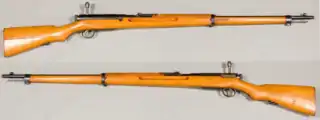 Type 38 rifle from the collections of the Swedish Army Museum | |
| Type | Service/bolt-action rifle |
| Place of origin | Empire of Japan |
| Service history | |
| In service | 1906–1945 (Japan) |
| Used by | See Users |
| Wars | World War I Russian Civil War Second Sino-Japanese War World War II Chinese Civil War Indonesian National Revolution Malayan Emergency Korean War First Indochina War Vietnam War |
| Production history | |
| Designed | 1905 |
| No. built | 3,400,000 |
| Variants | Carbine & Cavalry Carbine |
| Specifications | |
| Mass | 4.19 kg (9 lb 4 oz)[1] 3.3 kg (7 lb 4 oz) (carbine) |
| Length | 1,275 mm (50.2 in)[1] 966 mm (38.0 in) (carbine) |
| Barrel length | 797 mm (31.4 in) 487 mm (19.2 in) (carbine) |
| Cartridge | 6.5×50mm Arisaka |
| Caliber | 6.5 mm |
| Action | Bolt action |
| Rate of fire | 10-15 rounds per minute[1] |
| Muzzle velocity | 762 m/s (2,500 ft/s) Type 38 cartridge[1] |
| Effective firing range | 366–457 m (400–500 yd) (with iron sight)[1] |
| Maximum firing range | 2.37 km (1.47 mi) (6.5×50mm Arisaka)[1] |
| Feed system | 5-round magazine |
History and development
The Imperial Japanese Army introduced the Type 30 rifle in 1897. However, the weapon had numerous shortcomings, which were highlighted by combat experience in the early stages of the Russo-Japanese War. These included bursting cartridges, a poorly designed lock in which excess gunpowder tended to accumulate, burning the face of the shooter, frequent misfires, jamming, difficulty in cleaning, and cartridge extraction. Major Kijiro Nambu undertook a redesign of the Type 30, which was introduced in 1906. Nambu reduced the number of parts making up the Type 30's bolt from nine to six and at that same time simplified manufacture and disassembly of the bolt without the need for tools.[3] A dust cover was added because of experiences in the Russo-Japanese War that left rifles inoperable from dust.[4] The weapon was produced in several locations:
- Tokyo Arsenal from 1906 to 1932; 2,029,000 units (est.)[5]
- Kokura Arsenal from 1933 to 1941: 494,700 units (est.)[5]
- Nagoya arsenal from 1932 to 1942: 312,500 units (est.)[5]
- Jinsen (in what is now Incheon) arsenal from 1942 to 1942: 13,400 units (est.)[5]
- Hoten (was called Mukden Arsenal before the Japanese took it over.[6] In what is now Shenyang) arsenal from 1937 to 1944: 148,800 units (est.)[5]
By 1940 more than three million Type 38s had been issued to the Imperial Japanese Army. However, a concern that the 6.5×50mmSR Arisaka cartridge did not compare favorably to the ammunition used by the other great powers in the war led to the introduction of a further generation of rifles in 1939, during the Second Sino-Japanese War. Designated the Type 99 rifle, this new rifle used the more powerful 7.7×58mm Arisaka cartridge already in use with the Type 92 heavy machine gun and the Type 97 light machine gun. However, not all units received the new weapon, and the mixture of types with incompatible cartridges led to considerable logistics issues during World War II.
Description and variant types
The Type 38 rifle used the 6.5×50mm Arisaka cartridge. This cartridge produces little recoil when fired. However, while on par with the Norwegian and Italian 6.5mm military cartridges of the time, the 6.5×50mm was not as powerful as several others in use by other nations. The Type 38 at 128 cm (50.4 in) was the longest rifle of the war, due to the emphasis on bayonet training for the Japanese soldier of the era, whose average height was 160 centimeters (5 ft 3 in).[7] The rifle was even longer when the 40 cm (15.75 inches) Type 30 bayonet was fixed. The Type 38 was fairly heavy, at about 4.25 kg.
Post-war inspection of the Type 38 by the U.S. military and the National Rifle Association found that the Type 38's receiver was the strongest bolt action of any nation's[8] and capable of handling more powerful cartridges.
Nomenclature note: In the West, Japanese equipment is commonly referred to as "Type XX", rather than "Model XX". In the case of a firearm, "Model" is a more accurate interpretation of the SHIKI (式) character, but the word "Type" has become well-established by collectors for decades.
Type 38 carbine
Intended for use by cavalry, engineers, quartermasters and other non-frontline troops, the Type 38 carbine was introduced into service at the same time as the standard Type 38. Its barrel was 487 millimeters (19.2 in), overall length 966 millimeters (38.0 in), and weight 3.3 kilograms (7.3 lb). The rifle lacked a bayonet. It was produced in a number of locations:
Type 44 carbine
Similar to the Type 38 carbine from the middle band back. The cavalry carbine is almost entirely different from the middle band forward with an under-folding bayonet, metal nosecap, stacking hook to the left side of the nosecap and wide front sight guards. This model was introduced in 1911. There are three variations of this rifle. Each variation based entirely on the nosecap size and the spacing of the nosecap screws. They have a unique storage compartment in the buttstock for a cleaning rod.
Type 97 sniper rifle
As with the standard Type 38, but with a rifle scope with 2.5x magnification, introduced in 1937. The scope was offset to allow loading by stripper clip and bolt handle slightly bent down. Some 14,000 were produced.
Type 38 short rifle
In the late 1930s to the early 1940s, an unknown number of Type 38 rifles were converted into short rifles at Nagoya Arsenal, that did all rebuilds of Type 38 and Type 44 rifles and carbines.[10] The barrels were shortened to 635 mm (25.0 in) from the standard 794 mm (31.3 in) barrel and the stock shortened to match the barrel while the handguard retained its original length.[11] The end result is a Type 38 which is similar in size to the Arisaka Type 99 short rifle. There is no consistency to serial numbers or arsenal marks as the rifles were converted from existing stock. Although total production is unknown, it is estimated that approximately 100,000 were converted.[12]
Chinese Six/Five infantry rifle
Chinese copy of the Japanese Type 38 at the Taiyuan Arsenal in the very late 1920s to early 1930s for the warlord of Shansi province, General Yen Hsi-shan. The receiver is marked 六五步槍 or "six-five rifle". Estimated to have been 108,000 made.[13]
Type 918 rifle
These copies of the Type 38 rifles are believed to have been manufactured at the South Manchuria Army Arsenal (also known as the 918 Arsenal), but very little is known about them. Chinese sources state that these rifles were made in China for Japan, but for whom it is not known. It does not bear the Japanese Imperial Chrysanthemum, but instead has a heart symbol and under it written "918 Type" (九一八式). It is also not known if these were made before or right after the surrender of Japanese forces. It has an under-folding bayonet similar to the Japanese Type 44. The 918 stamped on top of the receivers stands for the date of September 18, 1931; the date of the Mukden Incident.[14]
North China Type 19 carbine
A relatively crude copy of the Type 38 carbine that is believed to have been made mostly in the Chinese city of Tientsin and may have been intended for puppet troops. Unlike the other Type 19 that is a copy of the Type 30 carbine, but in 7.92×57mm Mauser, this Type 19 is chambered in the Japanese 6.5x50sr cartridge. Like the other Type 19, it also has a cherry blossom on the receiver and not the Japanese Imperial Chrysanthemum and also says "North China Type 19" (北支一九式). The 19 may mean the 19th year of Showa Era or 1944. The true military designation is unknown. Approximately 40,000 carbines are thought to have been produced.[15]
Siamese Type 66 long rifle
Siam (Thailand) ordered 50,000 Type 38 rifles in 1924 from the Tokyo Army Arsenal chambered in their Type 66 8x52r cartridge. The receiver is marked with the Siamese Charkra with "Type 66" (แบบ ๖๖) written under it. Not only was the caliber changed, but the sights, bayonet and cleaning rod are different than the Japanese version. Almost all parts, including screws cannot be interchanged with the Japanese Type 38.[16]
Thai Type 83 rifle
Unlike the Siamese Type 66 (แบบ ๖๖), this rifle is a standard Japanese Type 38 in 6.5x50sr that was sent as aid from Japan to Thailand in 1940. These were taken straight from assembly lines at Nagoya and Kokura arsenals, after the Japanese Imperial Chrysanthemum was canceled out by zeros along the petals. In Thailand they called it the Type 83 (แบบ ๘๓). These rifles were issued to second-line troops to free up rifles in their main caliber from front line duties for the Franco-Thai War.[17] Later in the 1950s, some of these rifles had their barrels and stocks cut down to short rifle length with many of those being rechambered for .30-06 Type 88 cartridge and becoming Type Type 83/88s (แบบ ๘๓/๘๘).[18] Very few of these rifles were imported into the United States because of the Gun Control Act of 1968 restricting former military arms from entering the country.[19]
Thai Type 91 police carbine
Made after World War II, these carbines were made in Thailand at the Royal Thai Arsenals in Bangkok from Type 38 parts for a handy carbine for police. The stock and barrel was cut down. The stocks were cut out like a M1 carbine stock and used M1 carbine slings and oilers. Some bolts were turned down, some not. Some had the Royal Thai Police symbol stamped on the receiver with "91" (๙๑) stamped above it and some received the Siamese Charkra stamped on the receiver. They all retained their original Japanese caliber of 6.5x50sr.[20]
Mexican Model 1913 rifle and carbine
Ordered in mid 1913 by the Huerta government in the standard Mexican military caliber, 7×57mm Mauser, for 50,000 rifles and later for another 25,000 carbines from the Tokyo Artillery Arsenal. They were made to fit the Mexican Mauser model 1895, 1902 or 1910 bayonets. In early 1914 the first 10,000-15,000 rifles arrived in Mexico, but the Japanese suspended, probably because Huerta had fled the country in mid-1914 and feared they would not be paid for the rest. In late 1914 or early 1915 Imperial Russia, desperate for arms, bought the remainder left in Japan which was either 35,400 or 60,000 rifles and carbines. The first few thousand rifles had three interlocking circles on the receiver, the rest had the Mexican crest under "Republica Mexicana".[21]
Estonian KL .303
Estonian conversion of standard Type 38 to .303 British cartridge, intended for usage by second line troops of the Estonian Defence League. Total 24,000 rifles were rebored during 1929-1934.[22]
7.62x39 conversion
After World War II, a lot of Type 38s were converted for use by China by switching to the 7.62x39 caliber since they were being equipped with AK and SKS rifles.[23]
Two versions of the converted Type 38s consisted of rifles with just a SKS barrel.[23] Another version consisted of a SKS barrel with a front stock cap and folding bayonet.[23]
Users
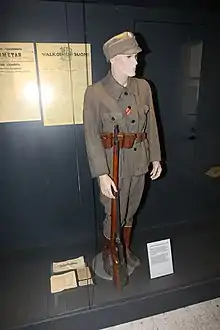
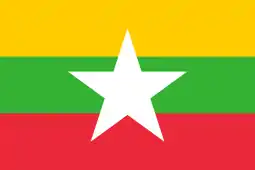 Myanmar: used by the Burmese Independence Army.[24] Used by Myanmar Army till 1960s.[25]
Myanmar: used by the Burmese Independence Army.[24] Used by Myanmar Army till 1960s.[25] People's Republic of China: In service during the Chinese Civil War[26] and the Korean War.[27] Still in service as Type 65 with the Red Guards militia in the 1960s.[28]
People's Republic of China: In service during the Chinese Civil War[26] and the Korean War.[27] Still in service as Type 65 with the Red Guards militia in the 1960s.[28].svg.png.webp) Republic of China: Japan sent more than 200,000 Type 38 rifles and carbines to China in 1917-1918, including 125,000 to the central government. The delivery to various warlords continued in the 1920s. The Whampoa Military Academy obtained Type 38s from the Soviet Union as military aid,[29] as did Feng Yu-hsiang's warlord army.[30] The pro-Japanese Collaborationist Chinese Army also received Type 38 rifles in the 1940s[31] while many more rifles were captured by anti-Japanese forces. Chinese copies were also locally produced.[32]
Republic of China: Japan sent more than 200,000 Type 38 rifles and carbines to China in 1917-1918, including 125,000 to the central government. The delivery to various warlords continued in the 1920s. The Whampoa Military Academy obtained Type 38s from the Soviet Union as military aid,[29] as did Feng Yu-hsiang's warlord army.[30] The pro-Japanese Collaborationist Chinese Army also received Type 38 rifles in the 1940s[31] while many more rifles were captured by anti-Japanese forces. Chinese copies were also locally produced.[32] Estonia: Ex-Russian stock used in the Estonian War of Independence, later, 24,000 Type 38s were converted to the KL .303 variant
Estonia: Ex-Russian stock used in the Estonian War of Independence, later, 24,000 Type 38s were converted to the KL .303 variant Finland: Ex-Russian stock[33]
Finland: Ex-Russian stock[33].svg.png.webp) France: Purchased during World War I
France: Purchased during World War I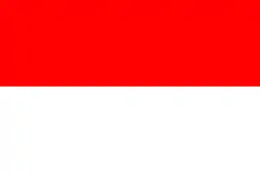 Indonesia: Captured Japanese weapons after Japan's World War II surrender and used them in the Indonesian Independence War.[34][35]
Indonesia: Captured Japanese weapons after Japan's World War II surrender and used them in the Indonesian Independence War.[34][35].svg.png.webp) Empire of Japan: 3.4 million were produced during World War II
Empire of Japan: 3.4 million were produced during World War II Manchukuo: the cavalry of the Manchukuo Imperial Army received 50,000 Type 38 carbines in 1935 while the front-line infantry was re-equipped with Type 38 rifles between 1935 and the early 1940s[36]
Manchukuo: the cavalry of the Manchukuo Imperial Army received 50,000 Type 38 carbines in 1935 while the front-line infantry was re-equipped with Type 38 rifles between 1935 and the early 1940s[36] Malaysia: Used by the Malayan Communist Party in the Malayan Emergency[37]
Malaysia: Used by the Malayan Communist Party in the Malayan Emergency[37] Mexico: The Mexican government ordered 75,000 rifles and carbines chambered for the 7×57mm Mauser cartridge in 1913, but only 10,000-15,000 were delivered before the overthrow of president Victoriano Huerta in 1914 suspended the order
Mexico: The Mexican government ordered 75,000 rifles and carbines chambered for the 7×57mm Mauser cartridge in 1913, but only 10,000-15,000 were delivered before the overthrow of president Victoriano Huerta in 1914 suspended the order Philippines: Filipino guerrillas used captured Type 38 rifles.[38] A handful remained in military and police armories which saw limited use in CAT, ROTC, and military academies.
Philippines: Filipino guerrillas used captured Type 38 rifles.[38] A handful remained in military and police armories which saw limited use in CAT, ROTC, and military academies.
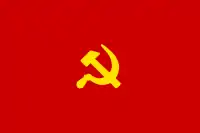 Hukbalahap: Utilized captured rifles from the Japanese occupation and continued using these in limited numbers during the early phase of the Hukbalahap Rebellion.
Hukbalahap: Utilized captured rifles from the Japanese occupation and continued using these in limited numbers during the early phase of the Hukbalahap Rebellion.
.svg.png.webp) Second Polish Republic: Ex-Russian stocks of Arisaka Type 30 (c.1897AD), Type 35 (c.1902AD) and Type 38 (c.1905AD) rifles and carbines.[39] The Arisaka Type 38 rifle was classified as the karabin japoński wz.05 Arisaka and the Arisaka Type 38 Carbine was the karabinek japoński wz.05 Arisaka. They were issued to police, border guards and paramilitary militia formations.
Second Polish Republic: Ex-Russian stocks of Arisaka Type 30 (c.1897AD), Type 35 (c.1902AD) and Type 38 (c.1905AD) rifles and carbines.[39] The Arisaka Type 38 rifle was classified as the karabin japoński wz.05 Arisaka and the Arisaka Type 38 Carbine was the karabinek japoński wz.05 Arisaka. They were issued to police, border guards and paramilitary militia formations. Russian Empire: During World War I, bought the remaining 35,400 rifles originally intended for Mexico, and also received 128,000 Type 30 and 38 rifles from Britain in 1916.[34] This in addition to about 600,000 in 6.5 mm ordered directly from Japan.[40]
Russian Empire: During World War I, bought the remaining 35,400 rifles originally intended for Mexico, and also received 128,000 Type 30 and 38 rifles from Britain in 1916.[34] This in addition to about 600,000 in 6.5 mm ordered directly from Japan.[40].svg.png.webp) Spanish Republic: Used Japanese and Mexican variants sourced from the USSR during the Spanish Civil War. Some examples were converted to 8mm Mauser. [41]
Spanish Republic: Used Japanese and Mexican variants sourced from the USSR during the Spanish Civil War. Some examples were converted to 8mm Mauser. [41]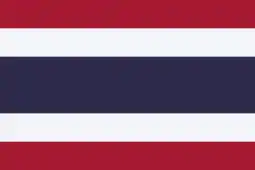 Thailand: Type 66, Type 83 and Type 91
Thailand: Type 66, Type 83 and Type 91 United Kingdom: Bought a mixed batch of 150,000 Type 30 and Type 38 rifles from Japan at the start of World War I to equip the Royal Navy, freeing up Lee-Enfield rifles for the British Army. Most were used by training battalions and the rifles were declared obsolete in 1921[42] According to another source, Japanese exports of this model were much greater: 500,000 to Great Britain and 620,000 to Russia.[43]
United Kingdom: Bought a mixed batch of 150,000 Type 30 and Type 38 rifles from Japan at the start of World War I to equip the Royal Navy, freeing up Lee-Enfield rifles for the British Army. Most were used by training battalions and the rifles were declared obsolete in 1921[42] According to another source, Japanese exports of this model were much greater: 500,000 to Great Britain and 620,000 to Russia.[43]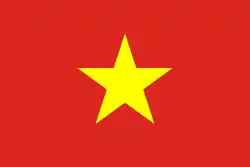 Vietnam: Captured rifles seized from the troops of Japanese occupation troops in Indochina, and later used by the Viet Minh during the war in Indochina with France[44]
Vietnam: Captured rifles seized from the troops of Japanese occupation troops in Indochina, and later used by the Viet Minh during the war in Indochina with France[44]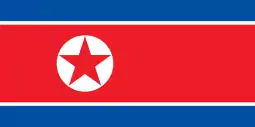 North Korea: Given by the People's Republic of China and The Soviet Union after World War II and was used throughout the Korean War
North Korea: Given by the People's Republic of China and The Soviet Union after World War II and was used throughout the Korean War South Korea: Given by the United States after World War II and was used in the early stages of the Korean War
South Korea: Given by the United States after World War II and was used in the early stages of the Korean War
Gallery
 Detail of rear sight of a Japanese Arisaka Type 38 rifle
Detail of rear sight of a Japanese Arisaka Type 38 rifle.JPG.webp) Top view of the rear sight on a Japanese Arisaka Type 38 rifle
Top view of the rear sight on a Japanese Arisaka Type 38 rifle Inscriptions on the upper handguard of a Japanese Arisaka Type 38 rifle
Inscriptions on the upper handguard of a Japanese Arisaka Type 38 rifle Inscriptions found on top part of receiver of a Japanese Arisaka Type 38 rifle (the "Imperial Chrysanthemum" is ground out)
Inscriptions found on top part of receiver of a Japanese Arisaka Type 38 rifle (the "Imperial Chrysanthemum" is ground out).JPG.webp) Detail of the front stock of a Japanese Arisaka Type 38 rifle
Detail of the front stock of a Japanese Arisaka Type 38 rifle Detail of the rear stock inscriptions on a Japanese Arisaka Type 38 rifle
Detail of the rear stock inscriptions on a Japanese Arisaka Type 38 rifle
References
- Allan and Macy. p.16
- Honeycutt and Anthony p. 84
- Allan and Macy. p.4-5
- Honeycutt and Anthony p. 38
- Allan and Macy. p.478
- Allan and Macy. p.30
- "Battle of the Pacific: How Japs Fight". Time magazine, February 15, 1943. Accessed June 24, 2009.
- Hatcher, p. 206, 210
- Allan and Macy. p.479
- Allan and Macy. p.234-235
- Allan and Macy. p.234
- Allan and Macy. p.235
- Allan and Macy. p.387-392
- Allan and Macy. p.398-401
- Allan and Macy. p.401-405
- Allan and Macy. p.421-427
- Allan and Macy. p.430
- Allan and Macy. p.431-432
- Allan and Macy. p.432-433
- Allan and Macy. p.434-440
- Allan and Macy. p.447-451
- Nõmm, Toe (2006), "Eesti Sõjapüssid 1918-1940", Laidoneri Muuseumi Aastaraamat 2005 (in Estonian): 73–74, ISSN 1406-7625
- https://www.forgottenweapons.com/rifles/arisakas-in-7-62x39mm/
- Scarlata, Paul (May 2012). "The military rifle cartridges of Burma/Myanmar". Shotgun News.
- Scarlata, Paul (May 2012). "The military rifle cartridges of Burma/Myanmar". Shotgun News.
- McNab, Chris (2002). 20th Century Military Uniforms (2nd ed.). Kent: Grange Books. p. 45. ISBN 1-84013-476-3.
- Rottman, Gordon L. (December 2002). Korean War Order of Battle: United States, United Nations, and Communist Ground, Naval, and Air Forces, 1950-1953. Praeger. p. 198. ISBN 978-0-275-97835-8.
- Smith, Joseph E. (1969). "Chinese communist militia weapons". Small Arms of the World (11 ed.). Harrisburg, Pennsylvania: The Stackpole Company. p. 299.
- Ness, Leland; Shih, Bin (July 2016). Kangzhan: Guide to Chinese Ground Forces 1937–45. Helion & Company. p. 252. ISBN 9781910294420.
- Jowett, Philip (September 10, 2010). Chinese Warlord Armies 1911–1930. Men-at-Arms 463. Osprey Publishing. p. 22. ISBN 978-1-84908-402-4.
- Jowett 2004, p. 64.
- Ness & Shih 2016, p. 259.
- "Rifles part 5: Other Rifles Captured in 1918". Platoon Website. 2017.
- Walter, John (2006). Rifles of the World (3rd ed.). Iola, WI: Krause Publications. p. 34. ISBN 0-89689-241-7.
- Bloomfield, Lincoln P.; Leiss, Amelia Catherine (June 30, 1967). The Control of local conflict : a design study on arms control and limited war in the developing areas (PDF). 3. Massachusetts Institute of Technology. Center for International Studies. p. 91. hdl:2027/uiug.30112064404368.
- Jowett, Philip S. (2004). Rays of the rising sun : armed forces of Japan's Asian allies, 1931-45. 1, China & Manchukuo. Helion. p. 15. ISBN 9781906033781.
- "Arisaka Type 38 Rifle : Communist Terrorist". awm.gov.au. Australian War Memorial.
- Scarlata, Paul (December 20, 2009). "Small arms of the Philippine Constabulary: from Moro to Japanese and back again! Part 2". Shotgun News.
- IAA Forum General Discussion 6,5x50SR Arisaka in Polish Army
- John Walter (2006). The Rifle Story: An Illustrated History from 1756 to the Present Day. MBI Publishing Company. p. 185. ISBN 978-1-85367-690-1.
- Miranda, Frank. "Foreign Rifles of the Spanish Republic, 1936-1939". surplused.com. Retrieved June 23, 2020.
- Walter, John (2006). Rifles of the World (3rd ed.). Iola, WI: Krause Publications. p. 33. ISBN 0-89689-241-7.
- Rotem Kowner (2009). The A to Z of the Russo-Japanese War. Scarecrow Press. p. 40. ISBN 978-0-8108-7007-9.
- Windrow, Martin (September 20, 2018). French Foreign Légionnaire vs Viet Minh Insurgent: North Vietnam 1948–52. Combat 36. Osprey Publishing. pp. 24–25. ISBN 9781472828910.
- Daugherty III, Leo J. Fighting Techniques of a Japanese Infantryman 1941–1945: Training, Techniques and Weapons. Staplehurst: Spellmount, 2002. ISBN 1-86227-162-3.
- Hatcher, Julian S. General. Hatcher's Notebook. (1966) The Stackpole Company, Harrisburg, PA.
- Honeycutt Jr., Fred L. and Anthony, F. Patt. Military Rifles of Japan. Fifth edition, 2006. Julin Books, U.S.A. ISBN 0-9623208-7-0.
- Allan, Francis C. and Macy, Harold W. The Type 38 Arisaka 2007. AK Enterprises, U.S.A. ISBN 978-0-9614814-4-5.
External links
| Wikimedia Commons has media related to Type 38 rifle. |